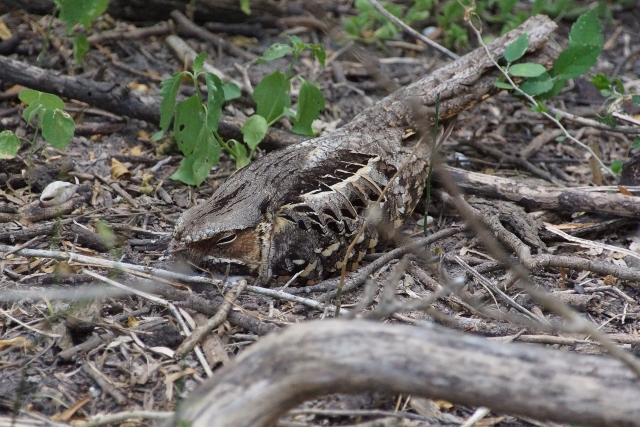
Common Pauraque – Master of Camouflage
by Linda Butcher, Texas Master Naturalist
Have you ever been walking through your favorite nature park on a brushy trail with abundant leaf litter on the ground and wondered what might be lurking nearby? If so, you may have passed right by a Common Pauraque — a tropical bird in the nightjar family whose northern range is South Texas.
More easily heard at night than seen during the day, their song can disrupt the still of the night with a nearly discernable, but eerie, “who-who-are-you?” The bird is quite attractive when you can distinguish it from its surroundings. The plumage is similar on both sexes. Their intricate feather pattern is in shades of brown and tan, which make it almost impossible to see with the casual eye. They quite simply look like a pile of sticks and leaves.
The bird has a large head and long, rounded wings and tail. During the day, the bird sleeps on the ground or rests in low hanging tree branches. They feed dusk to dawn on nocturnal insects scouted on the ground and then captured in flight. They have small beaks with very wide mouths surrounded by “whiskers” that appear to help them find insects in flight.
During breeding season, the Common Pauraque does not build a conventional nest, instead it nests on the ground. They lay two peachy-pink-colored eggs directly on the ground in leaf litter. This makes them vulnerable to predation by small mammals and snakes. Both the male and female share duties incubating the eggs as well as feeding the young hatchings.
The Common Nighthawk is a similar bird but has long slender wings and prefers more open habitat. You will see them flying high in the air at dusk. The Common Nighthawk makes a nasally frog-like call, not at all like the Pauraque. Other family members include Whip-poor-wills and Chuck-will’s-widows; all of which may visit the Rio Grande Valley during migration. The Common Pauraque is a year-round resident here and as far south as Argentina in South America.
Next time you’re out for a walk, see if you can find one of these masters of camouflage.
The Rio Grande Valley Chapter, Texas Master Naturalist develops knowledgeable volunteers dedicated to the study and conservation of natural resources and natural areas in the Lower Rio Grande Valley and helps the natural world through service, outreach and education.
